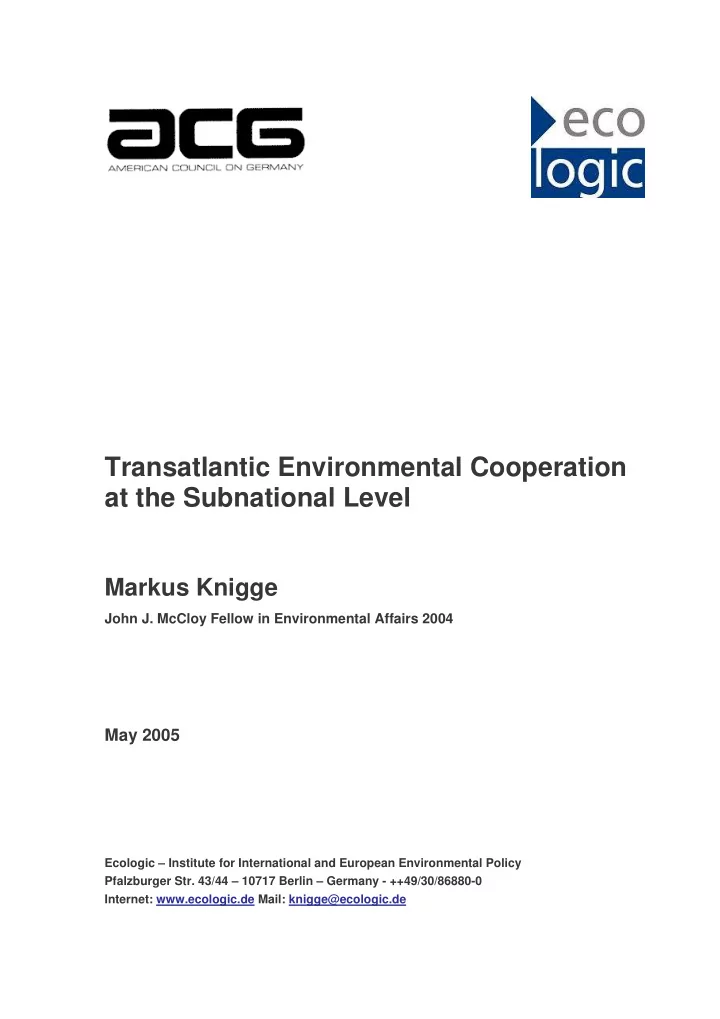

Transatlantic Environmental Cooperation at the Subnational Level Markus Knigge John J. McCloy Fellow in Environmental Affairs 2004 May 2005 Ecologic – Institute for International and European Environmental Policy Pfalzburger Str. 43/44 – 10717 Berlin – Germany - ++49/30/86880-0 Internet: www.ecologic.de Mail: knigge@ecologic.de
Transatlantic Environmental Cooperation at the Subnational Level Acknowledgements Over the course of the past months, I have benefited from the support of several European and U.S. partners, who have helped me to carry out this project. Foremost, I would like to thank the John J. McCloy Fund of the American Council on Germany for its generous financial support for this project. I am also grateful to my colleagues at Ecologic – Institute for International and European Environmental Policy for helping to scope the project and representing me in my ongoing projects at Ecologic during my absence. Finally, I am particularly grateful to all the people I met and inter- viewed during my four-week stay in the U.S. for their time, interest in this project and their valuable insights that reconfirmed my interest in this topic and guided the writing of this report. 1
Transatlantic Environmental Cooperation at the Subnational Level Table of Content 1 Background ...........................................................................................3 2 Project ....................................................................................................4 2.1 Aims of the Project..................................................................................... 4 2.2 Selection of Case Studies.......................................................................... 5 2.3 Methods and Approaches.......................................................................... 6 2.4 Caveats ........................................................................................................ 7 3 Transatlantic Environmental Cooperation..........................................7 3.1 Frameworks for Cooperation..................................................................... 7 3.2 Establishment of the Partnership ............................................................. 8 3.3 Objectives.................................................................................................. 10 3.4 Methods for Policy Learning ................................................................... 11 3.5 Participants in the Cooperation .............................................................. 14 3.6 Financing of Cooperation ........................................................................ 15 3.7 Environmental Issue Areas...................................................................... 16 3.8 Impact of Subnational Cooperation........................................................ 17 3.9 Reporting on Exchanges and their Impacts .......................................... 19 4 Challenges and Opportunities for Transatlantic Cooperation........20 4.1 Challenges................................................................................................. 20 4.2 Opportunities ............................................................................................ 21 5 Conclusions and Questions for further research.............................23 6 Annex ...................................................................................................26 6.1 Questionnaire............................................................................................ 26 2
Transatlantic Environmental Cooperation at the Subnational Level 1 Background Many environmental problems are of a global nature and are characterized by their cross-border impacts. Therefore international and global efforts, such as those demonstrated in the large number of multilateral environmental agreements, are usually regarded as the best means to address these issues. Transatlantic cooperation on a number of environmental issues, however, is currently affected by present tensions in the transatlantic relationship. In fact, the conflicting perspectives on climate change, genetically modified organisms or the precautionary principle in the Convention on Biodiversity are frequently viewed as irreconcilable differences between the U.S. and Europe. While recognizing that global issues deserve global responses, it is important to realize that all of these issues, as they pertain to Europe and the United States, involve local or land-use issues. A great deal of the implementation and practice of environmental protection aimed at addressing global problems takes place among sub-national actors at the local, regional and state level. For example, in the United States, most greenhouse gas emissions emanate from the transportation and building sectors and are accordingly dealt with at the local transportation level and in the building arena. Moreover, in the United States, one of the greatest threats to marine protection emanates from habitat loss and urban settlements along coastal areas: problems that must be dealt with locally. Consequently, local and regional institutions are key to effectively dealing with both local environmental problems and global environmental challenges. Subnational authorities also play a crucial role in the formation of environmental policies at the federal level. Most likely the best-known example is California’s vehicle emission standards setting. It was, after all, legislation adopted by California that prodded Congress to enact the first federal Clean Air Amendments “with teeth” in 1970. 1 Ever since, California has pushed further in the direction towards zero emissions and contributed to stricter emissions standards not only in other states but also at the federal level (end even internationally given its market size). Yet another example is currently evolving in the area of climate change policy. Since the Kyoto Protocol on climate change came into force the United States has been effectively on the sidelines. Yet 154 U.S. cities have their own plans to fight global warming - as part of a growing network organized by the International Council for Local Environmental Initiatives. 2 At the state level, Northeastern and Mid-Atlantic states joined in a Regional Greenhouse Gas Initiative to develop a regional strategy for controlling emissions, including a multi- 1 State Environmental Resource Center: California’s Motor Vehicle Emissions Program: http://www.serconline.org/pdf/EmissionsBooklet8-5.pdf. 2 Rosanne Skirble (2005) US States Take Leadership Role in Addressing Climate Change, available online at: http://www.axcessnews.com/environmental_021705a.shtml. See also ICLEI’s International Framework for Local Action: Cities for Climate Protection at: http://www3.iclei.org/localstrategies/summary/ccp2.html. 3
Recommend
More recommend